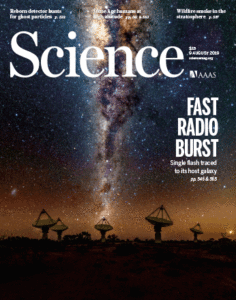The team of scientists who first traced the source of an ultra-short radio burst in the sky in 2019 will today receive the AAAS Newcomb Cleveland Prize from the American Science Association AAAS. The team includes Nikhef staff member Mieke Bouwhuis, who streamlined the timing of the groundbreaking measurements.
At the time, the discovery of the ASKAP radio telescopes in Western Australia adorned the cover of the leading AAAS journal Science. In the accompanying article, the researchers described how an ultra-short radio burst had to have come from a distant medium-sized galaxy.

The annual award carries a sum of 25 thousand dollars. The awarded work must have previously appeared in the journal Science and represent a scientific breakthrough.
Until its discovery in August 2019, the origin of such fast radio bursts (FRB) was a mystery to astronomers. Since then, multiple observations of the radio burst have been made, especially with ASKAP. The signals, which last only a few microseconds, are believed to come from the outskirts of medium-sized galaxies.
Previously, astronomers suspected that they must have something to do with black holes in the center of the galaxies, but that idea is now off the table.
FRBs themselves have been known to astronomers since the 1980s, but for a long time it seemed impossible to determine their origin because they are always one-off bursts. A radio telescope should pick up such a radio flash by chance and then immediately collect all available information.
The measurements took advantage of the idle moments between other measurement programs with the ASKAP telescopes.
Each radio dish at the Murchison Radio-astronomy Observatory in Western Australia was equipped for this purpose a receiver with 188 smaller radio antennas with associated electronics. Bouwhuis designed a system to capture all ASKAP signals with exactly the same timing.
Bouwhuis is currently assisting Nikhef in the construction of the large KM3NeT neutrino measurement network in the Mediterranean Sea near Toulon and Sardinia. In a few years’ time, this will consist of thousands of light sensors on sunken cables in the deep sea. From the combined sensor signals, the tracks of cosmic particles can be reconstructed. There, too, synchronization of the measurements is essential.